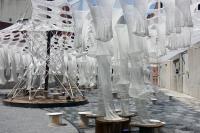Tamaranzaka House
Tokyo, Japan
Due to Tokyo’s high land prices, plot sizes become reduced as a matter of necessity. What’s more, buildings often become even smaller in order to satisfy strict building regulations. As a result, architects working on residential projects in the Japanese capital are universally concerned with how to maximize the physical area of these buildings within a limited space, as well as how to produce a feeling of openness and breadth. Many clients are also concerned with how to provide adequate storage within a small space, and how to create a comfortable environment.
For this residence, we focused on two components within the existing floor plan of this two-storey wooden structure that tend to be neglected – the roof space above the ceiling, and the portion underneath the floor. The first step was to divide the roof and floor on each level into an upper and lower portion. By freely carving out a part of each of these upper and lower portions, several spaces were created – a dining area, a place for relaxing, and a workspace. In contrast, the gouged-out holes helped to frame free, unobstructed lines of sight that created gentle links between the different spaces. The in-between gaps that belonged to neither of these spaces could then be used for storage purposes, in addition to indirectly helping to augment the floor area of the living space.
The lower portion of the floor on the ground storey was lowered down onto the base support, while storage space was built into the gap between this lower portion and the upper one, allowing us to create a rational layout that did not require us to make any improvements to the foundations.
Although small, the wooden framework projects a strong sense of volume and texture while also imparting a certain delicacy to the entire space. For our future projects, we hope to be able to create buildings that take advantage of the distinctive characteristics of the materials involved, creating unique, site-specific architecture, regardless of its framework or structure.
Project Outline
Location : Kokubunji-City, Tokyo
Date of Completion : 2009
Principal Use : Residence & Atelier
Structure : Wood
Site Area : 82.79m2
Total Floor Area : 65.30m2 (32.19m2/1F, 33.10m2/2F)
Structural Engineer : Kenji Nawa / Nawakenj-m
Mechanical Engineer :
Material Information
Exterior Finish : Wet wall
Roof : Galvanized color steel sheet standing-seam roofing
Floor : White oak flooring
Wall : Acrylic emulsion paint + plaster board
Ceiling : --









